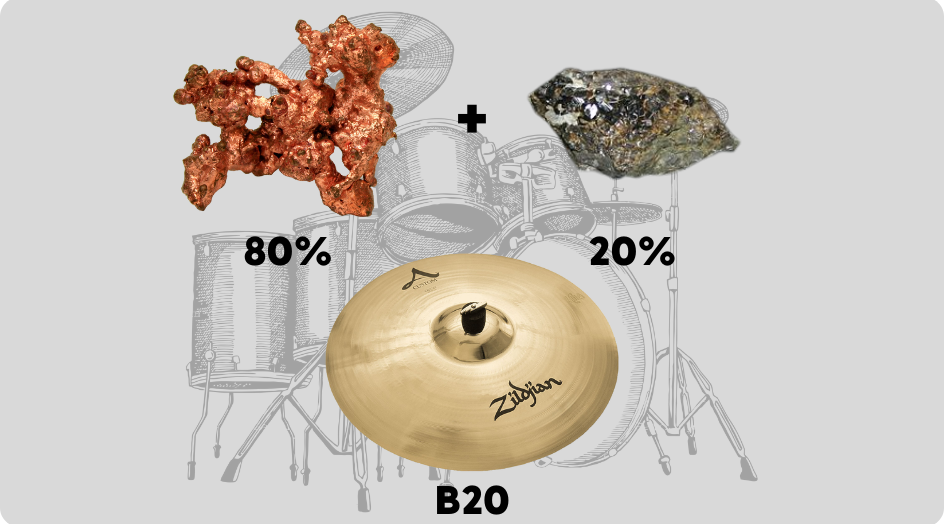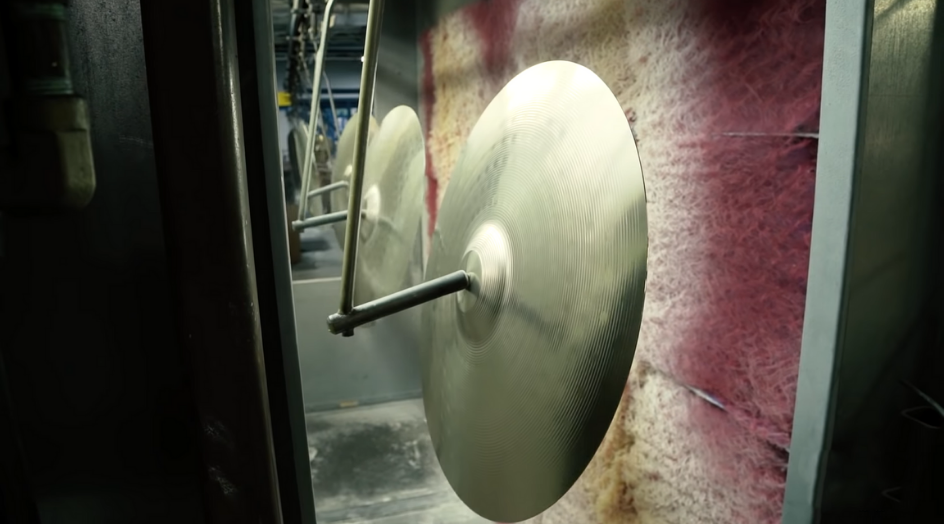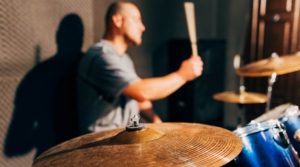The quality of your instruments can significantly affect the quality of your drum playing — which is why knowing what are cymbals made of is essential. If you are looking to buy your first set of cymbals or want to upgrade from your old ones to new ones, this article will be very helpful as you will learn:
- what alloys are used to create cymbals
- how the materials affect the durability and sound
- which options are the best for you
If you were wondering why some drummers can add excellent dynamics when they hit their kits, it is because of the time and effort they put into practice. However, having a good set also helps a lot.
Having good-sounding crashes and rides can help with your head-turning drum solos, especially if you want to add dynamics and exquisite detail when playing drums. Plus, it will also help when recording your drum parts for cleaner tracks in the booth.
Typically, they are made out of copper alloy because of their desirable sound properties. However, different brands have their own take on the materials they use when making their products –adding innovative technology and other alloys makes them sound superior.
When choosing the best cymbals and materials used, you have to consider the durability and the sound. You want these instruments to ring and you want it loud, whether you are playing in a rock band, a marching band or you just want to wake someone up from their deep slumber — like this guy right here:
But Asaph….lol 1 Chronicles 16:5 KJV
[5] Asaph the chief, and next to him Zechariah, Jeiel, and Shemiramoth, and Jehiel, and Mattithiah, and Eliab, and Benaiah, and Obed-edom: and Jeiel with psalteries and with harps; BUT ASAPH MADE A SOUND WITH CYMBALS; pic.twitter.com/DNt5xJXMsq— PaulsCorner21 (@TNTJohn1717) November 19, 2021
What Are Cymbals Made Of?
As I mentioned before, they are typically made out of different copper alloys, depending on the brand. If you don’t know what alloys are, they are a blend of two or more types of metals fused together.
Copper has excellent malleability, which makes it more durable and perfect for hitting it hard. But one of the best things about copper is its sonic properties.
Common Copper Alloys
- Bronze
- Silver
- Copper
- Tin
- Brass
- Nickel
Although these are the most common types of metals used in making cymbals, different companies experiment with the ratios.
If you are at a music store, you will find choices such as B20 bronze or bell bronze, which is 80% copper and 20% tin. You will also find B8 bronze, which is an excellent choice since it is made with 92% copper for better malleability and 8% tin — making it a more affordable choice if you are a beginner.
Well-known companies like Zildjian, Paiste, Sabian, and Meinl like to experiment with their tin copper ratios to get the perfect tone for each cymbal type. But their primary goal is to create instruments with the best sound and strongest quality — which are the two things you mainly have to consider when buying your first ride, crash, china, or gong.
Here is a quick look at how Paiste, one of the best cymbal makers in the business, makes their top-notch products.
Do you want to take a Paiste deep dive? Would you like to know how a Paiste Cymbal is made? 🤔🤷
No problem. Get ready for the “all in” documentary on the art of cymbal making.
▪️
Full documentary by Drumeo:
▶️ https://t.co/9VcNW04iV3
▪️#paiste #cymbals #drumeo #drums pic.twitter.com/6W82e66yKZ— Paiste Cymbals (@PaisteNation) November 17, 2021
Cymbals are made differently. Some companies cast it by melting the metal and pouring it into a mold. Then they let it cool down until it is ready to be taken out of the mold.
Other companies use hammering, which involves shaping and strengthening the materials by hitting them manually or by using a machine.
Different companies make their products. Zildjian creates their instruments using different techniques like hammering, casting, or a combination of the two.

Ideally, as a musician, your best bet is to go for the best sound. However, the real question is — what is the best sound?
Considering that there are different genres, personal preferences, and performance settings — there is no one cymbal that can do it all. Drummers like to mess around with different kits, combinations, and types, so knowing what are cymbals made of is very essential to drummers.
But not everyone can afford $500 crashes and rides, especially if you are a beginner. With that being said, you don’t really need to indulge in expensive gear if you can’t — all you need to do is learn the basics of what are they made of and choose an option that fits your musical needs.
Here is a quick rundown of the available options for you.
The Most Common Types of Materials
Cymbals, just like any other part of your drum kit don’t last forever. I have been a touring drummer for quite some time now, and I have tried out different types with different copper to tin ratios.
Based on my experience with recording and live performances, here are some of the materials that I have used along the way, in case you are still wondering what are cymbals made of:
Bronze in General
I started drumming without knowing the basics of cymbals, which is why I want to share my experience, so you already know where to start.

Bronze comprises the vast majority of any alloys, and if you are a beginner, basic bronze cymbals are a good place to start. The less tin in the mixture will give you a brighter sound and higher frequencies, which is probably why hi-hats and crashes have more copper and less tin in the mixture.
However, adding more tin in the mixture gives you a richer and more sustained sound, which is excellent for dynamics, making it a good choice for bell sounds.
When choosing basic bronze cymbals, the general rule of thumb is that the higher the tin to copper ratio, the more expensive they are.
However, it also depends on the brand. Zildjian likes to add more copper and less tin for a brighter sound when playing rock music. While brands like Paiste like to add more tin in the mix for a richer sound like their pro-quality series that uses B8 bronze — which I definitely love using for playing technical drum tracks.
B20 Bronze
You will find a lot of options labeled with B20, whether it is from brands like Paiste, Sabian, or Zildjian. This bronze is 80% copper and 20% tin, and some might even add traces of silver in the mix as well.

Although the process of reworking B20 is more challenging than B8, it is still used up to this day, and it is still the most common option if I may add.
Zildjian has been using B20 for over 400 years, which pretty much means that they are very effective when making the best cymbals. It offers a wide range of frequencies, which is excellent for versatility in your drum playing.
With B20 cymbals, you can play any genre from rock to jazz and even pop. Zildjian uses B20 alloy in many of their custom series because they find it very effective and in line with their signature sound and quality.
I have been using B20s for playing rock music, but because of their sustaining qualities, you can also use them for more dynamic drumming like in jazz, blues, and pop.
B8 Bronze
B8 Bronze has more copper in the mix. It is 92% copper and 8% tin, and it is an excellent choice for making entry-level cymbals for beginners.

B8s are usually cast by the supplier before being brought in to the cymbal companies, making them cheaper, but still good for playing bright tones.
Yes, you can’t avoid damaging your B8s, but the quality of the metal does not tarnish, which allows you to recycle them if you tear them apart with your insane shredding. You can sell them to a junk shop, use them for display, or you can do something clever with them.
Look at what the Full Circle Company did with their old cymbals:
Made from recycled cymbals by @fullcirclecompa. https://t.co/YmEjnhHhEr pic.twitter.com/lersq9s1QA
— Taking Back Sunday (@TBSOfficial) October 12, 2021
They made cool accessories like necklaces and bottle openers out of something that you probably thought you wouldn’t use anymore. So instead of letting your old ones end up in the dumpster —learn what are cymbals made of and create something cool out of them!
Brass
Although brass isn’t as popular as bronze when making cymbals anymore, companies like Zildjian and Paiste still use them for their low-end tier options.
If you are just thinking about learning how to play the drums and want the most affordable option in the market, you can probably get away with using Zildjian Planet Z Series or Paiste’s 101 Series.

These are the most affordable sets that you can buy separately. However, they are typically included in entry-level drum kits for beginners.
You can always upgrade to B8s or B20s down the road, and there is nothing wrong with starting with brass. But if you feel that you are going to be playing drums for a long time, you can always save up and buy better cymbals to save money in the long run.
Other Mixtures
 Nickel is still used for making cymbals, but not by a lot of companies. Paiste, for example, only uses nickel for other types that you wouldn’t normally use for playing rock music, such as gongs and other types.
Nickel is still used for making cymbals, but not by a lot of companies. Paiste, for example, only uses nickel for other types that you wouldn’t normally use for playing rock music, such as gongs and other types.
Meinl is one of the only manufacturers who experiment with using four kinds of bronze alloys. They use B10, which is 90% copper and 10% tin, and B12, which is 88% copper and 12% tin.
If you are a beginner, you wouldn’t know much of a difference, but B12 bronze has a darker tone than any of your B20s and B8s.
It doesn’t sound bad at all, and the right term would be — it sounds different.
How Are Cymbals Made
Lower quality cymbals are made from sheet metal, otherwise known as, sheet cymbals. This produces a very thin and ringing sound, which may not be what you are looking for, but is usually an essential part of beginner’s kits. Let’s dive into the process of making sheet cymbals from one of the major cymbal manufacturers.
Better quality cymbals are made by casting, so-called cast cymbals, in which the grooves are lathed. They use high-quality metals and can even be hand-forged to achieve a great-sounding cymbal. Check out Zildjian’s complete process for casting them.
Learn more
- Cymbal care & cleaning →
- Difference between ride and crash cymbals? →
- Salvage & repair cracked cymbals →
Conclusion
Now that you know what are cymbals made of, you can now go outlook for the best ones in the market for you and your drum style. a
Whether you are a beginner or pro, have knowledge on how your instruments are manufactured and the materials used in step-up when looking for the best sound. Practicing how to play can actually make your cymbals sound better — no matter what material is used to make them.
I had the pleasure of doing a little experimenting myself until I found the perfect cymbals for my kit, and I hope you learned a lot from this article. Have fun shredding!




